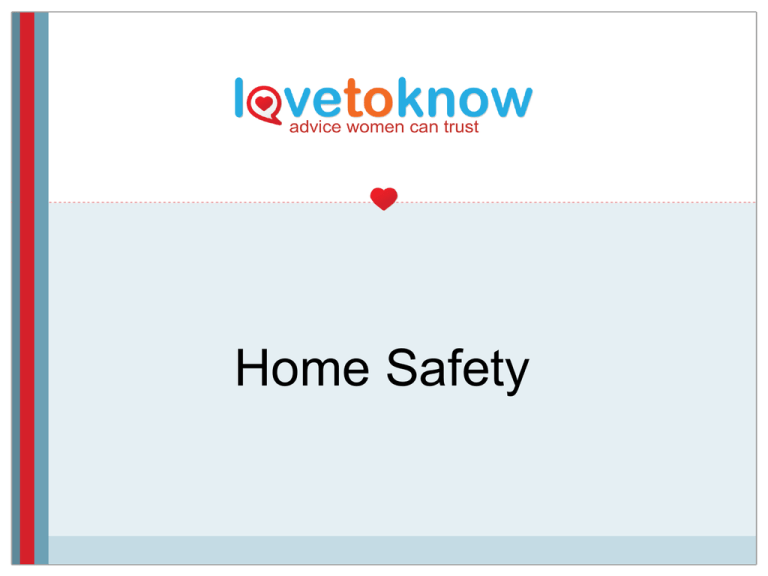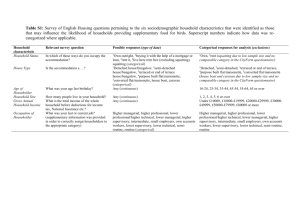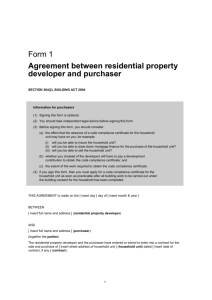Home-Safety
advertisement

Home Safety Stay Safe at Home Home safety is an important topic that needs to be “top of mind” in every household. Learn and follow important safety tips to help keep yourself and your family members as safe as possible at all times. Household Chemical Safety Most homes have cleaning solutions and other household chemicals that have the potential to be harmful to humans and/or pets if ingested or as a result of exposure. Household Chemical Safety Continued • Keep all chemical solutions tightly sealed. • Do not remove chemical solutions from their original containers. • Do not store chemicals in the same areas where food, beverages or medicine is stored. • Store chemicals in a secure area that cannot be accessed by children or pets. • Keep the poison control phone number handy in case of problems: 1-800-2221222. • Keep Material Safety Data Sheets (MSDS) forms on hand for the chemicals in your home so you know what to do as a result of exposure. • Many can be accessed online at http://hazard.com/msds/, http://www.msds.com/ and http://www.msdssearch.com/. • If you need MSDS forms that you cannot find, contact the manufacturer. Fire Safety Every family should be concerned about the dangers of fire. Take steps to make sure that you are prepared if such a situation occurs. Fire Safety Continued • Install smoke detectors in your kitchen, garage, all bedrooms and other areas of the home where appropriate, being sure they are installed on each level of your home. • Test smoke detectors regularly and change batteries when you set the clock forward and back each spring and fall. • Place fire extinguishers in key areas throughout your home (kitchen, bedrooms, garage, other areas as dictated by your habits) and ensure that household members know how to use them. • Establish a fire evacuation plan and be sure that everyone in your household knows what it is; practice via periodic fire drills. • If you have a two- or three-story home, be sure that portable fire escape ladders are accessible from upstairs rooms. • Make sure your street address is clearly visible from the street in case fire fighters (or other emergency service providers) need to be able to find your home. Fire Prevention It is, of course, also important, to take steps to minimize the risks of fire in your home by following appropriate fire prevention tips. Fire Prevention Continued • Do not leave the stove, oven, iron, grill or other similar items unattended when they are turned on. • Avoid placing space heaters or candles near fabric, bedding, or anything flammable. Keep these items away from areas where they can be reached or knocked over by children or pets. • Only use space heaters in areas that are properly ventilated. • Store matches and lighters in secure areas out of reach of children. • Store filled gasoline containers, firewood and any other explosive or combustible items away from your home or attached garage. • Have your heating system and fireplace serviced at the end of each summer so you can be sure they are safe to operate before the temperatures dip. • Keep your yard free of dead vegetation, twigs, straw, leaves, etc., as these items can pose fire risks. • Be sure to keep the lid on your trash can closed. Electrical Safety Safety concerns associated with electricity are related to both fire safety and personal safety. Take care to avoid electrical problems that could result in fires or cause injury to members of your household. Electrical Safety Continued • Use extension cords only as directed, being careful not to exceed recommended wattage • Do not place power cords under rugs or coil them up while in use. • Make sure that all of the outlets used by your appliances are grounded. • Regularly check ground fault circuit interrupters (GFI) • Place covers over electrical outlets that are not in use. • Never cut or alter a plug in order to get it to fit into an electrical outlet. Kitchen Safety Most people spend more time in the kitchen than in any other room of the home. With all of the potential safety risks in this room, it deserves special attention in any discussion of home safety. Kitchen Safety Continued • Store all sharp cooking utensils and serving ware in locations that cannot be easily accessed by children. • Make sure that knives are placed in storage areas with the blades pointing to the back, so the first thing you touch when reaching in is the handle. • Keep your refrigerator between 34 and 40 degrees Fahrenheit. • Keep your freezer between -10 and -20 degrees Fahrenheit. • Avoid thawing frozen food at room temperature, instead allowing it to thaw in the refrigerator or using your microwave. • Do not use food products past their expiration date, being aware that foods spoil more rapidly once they have been opened. • Install child proofing devices on cabinets if you have young children or pets who are able to get into cabinet doors. Slip and Fall Safety Many home injuries occur as a result of slips, trips and falls. Take steps to reduce this significant risk in your household. Slip and Fall Safety Continued • Ensure that each room of your home has proper lighting. • Ensure all interior and exterior stairway handrails are firmly affixed to the wall. • Make sure throw rugs are firmly affixed to the floor, or remove them. • Place “wet floor” signs out when areas are drying as a result of being mopped or having something spilled on them. • Periodically check door thresholds to ensure they are firmly held in place and that the flooring beneath them is not loose or fraying. • Get each household member in the habit of picking up after themselves so that items aren’t left on the floor in trafficked areas. • Alert household members about the importance of keeping walkways clear so they’ll pick up any items they see in the way, not just ones they are personally responsible for. • Avoid leaving electrical cords in areas where people walk. Home Invasion Safety Takings steps to prevent your home from being targeted by burglars is an important part of any comprehensive approach to home safety. Home Invasion Safety Continued • • • • • • • • • • • Do not leave keys to your home under the doormat, hanging on nails, placed in potted plants, or any other areas outside your home. When having your car serviced, do not leave your entire key ring; instead only give the key to your vehicle to the service technician. Install peep holes in your doors so that you never have to open the door without being sure of who is on the other side. Consider installing a burglar alarm system. Avoid leaving notes on the door alerting friends, delivery drivers, etc. that you are not in and when you expect to return. Don’t allow mail and newspapers to pile up when you are out of town; have someone gather them for you if you are going to be away. Turn down the ringer on your home phone when you are out so that a loud, unanswered phone does not alert potential intruders that the property is empty. Do not leave valuables lying around or in areas where they are visible through doors or curtains. Keep the doors and windows to your home closed and locked when you are not using them and when you are not at home. Plant shrubs beneath your windows to make it difficult for potential burglars to gain access through windows. Keep your garage door pulled down. More General Safety Tips • Gas exposure - If your home uses natural gas, be sure you have working carbon monoxide detectors stored. • Medication - Do not store medicine in the same areas as food and keep medications out of reach of children. • Furniture - Ensure bookshelves and other tall potentially tipping furniture pieces are affixed to the wall or secured in other ways. • CPR - Consider having adults and teens in your household become certified in cardio pulmonary resuscitation (CPR). You Can’t Be Too Careful When it comes to keeping yourself and your family safe, it’s not possible to be too careful. These are just a few of the important safety tips and guidelines that you may want to consider following in your home. Be proactive in continually improving home safety in your dwelling, including doing regular safety check-ups and engaging in ongoing education to teach each family member what he or she can do to make a difference. Sources • Underwriters Laboratory (UL) Safety at Home • National Capital Poison Center • University of Nebraska-Lincoln Food Safety • ADT Security Choice











